On Tuesday 20 March 2018 PicSat suddenly fell silent, after two successful morning passes over Europe. Attempts to re-establish contact have failed, nothing has been heard from the satellite, no sign of life. On Thursday 5 April 2018 the team decided to call the mission to an end. A “pot” (French for party / drink) was organized at noon at the Paris Observatory in Meudon. Sylvestre Lacour did a short speech. Four radio amateurs who have been PicSat fans and great support joined in via a dedicated Google Hangout.
UWE-3 celebrating 4 years of operation in space.
UWE-3 News: celebrating 4 years of operation in space.
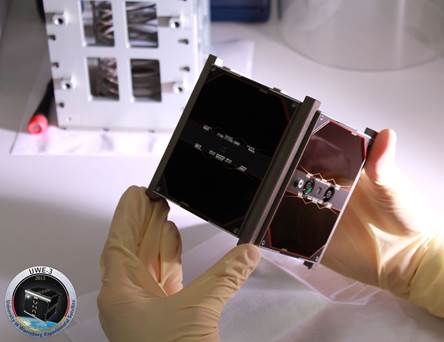
UWE-3 in clean room shortly before launch 2013.
During these last four years we received an outstanding support from the Radio Amateur Community from all over the world, which is highly appreciated. We would like to express our special thanks to:
DK3WN, Rainer, PE0SAT, SP7THR, EU1XX, JA1GDE, JA6PL, G7GQW, ON4HF, LU4EOU, DL8MCO, JA5BLZ, CU2JX, R4UAB, VK5HI, JA0CAW, IW0HLG, JO1PTD, YC3BVG, DB1VQ, JA6DHC, ZL4JL, VK2FAK, JE9PEL, JH4XSY, JF1EUY, N2ACQ, PY4ZBZ, CX8AF, DG4YDF, LU7DRR, PD0OXW, PA2EON, IK8OZV, ES5EC, K4KDR, ZR1ADC, JE1CVL, EA7ADI, EA1JM, PY2SDR, VE7CEW, PA3GUO, ES5TO, SM0TGU, EA4SG, DL1MX, W6YRA.
THANK YOU ALL FOR YOUR EXTRAORDINARY SUPPORT!
Yours sincerely,
UWE-3 Team.
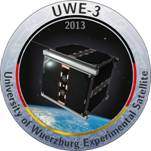
i-INSPIRE-2 activated
i-INSPIRE-2 activated with the help of the CAMRAS 25 meter dish
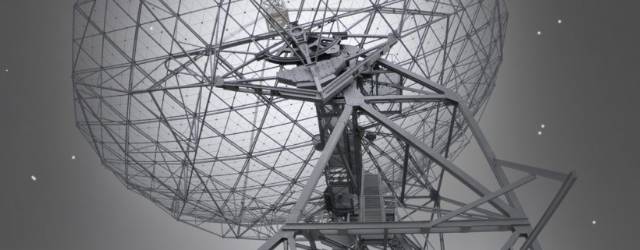
In the weekend of June 10/11, 2017 volunteers from the 25m dish in Dwingeloo The Netherlands where successful in activating the Australian QB50 satellite i-INSPIRE-2. This satellite is build at the Australian new south wales university for the QB50 project and is launched from the International Space Station, May 26 at 04:00 UTC. No signals where received and therefor help was requested from the CAMRAS team.
During a pass on Saturday June 10th 2017 signals where send to three QB50 cubesats i-INSPIRE-2 and UNSW-EC0 by the 25 meter dish and ZA-AEROSAT with the help from DK5LA. On Sunday signals where received from i-INSPIRE-2 by the CAMRAS dish and also by other radio amateurs over the world.
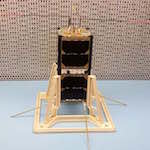 |
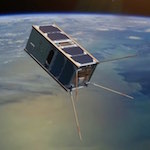 |
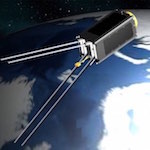 |
| i-INSPIRE-2 (AU) | UNSW-ECO (AU) | ZA-AEROSAT (SA) |
During a pass over the Netherlands I made an IQ recording and below the signals are clearly visible in the spectrum. The satellite TX/RX is similar to the GOMX-1 satellite at 4k8 baud, but I wasn’t able to decode them. If you want to play with the IQ recording, it can be downloaded at the following location: IQ recordings
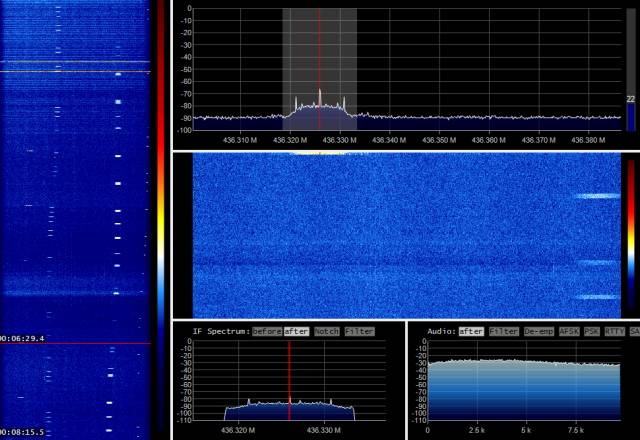
The other two satellites UNSW-ECO and ZA-AEROSAT are still quite but maybe there will be a second attempt. For the ZA-AEROSAT activation there is help from the german HAM radio station DK5LA who transmitted a very strong signal on 2 meter to this South African build satellite.
Update: June 13, 2017.
The following response was brought to my attention by PB2T.
I-Inspire-2 is a 20 x 10 x 10cm cubesat built by the University of Sydney in collaboration with the Australian National University and the University of New South Wales (Sydney). On board the tiny spacecraft is an experiment, part of the European QB50 project, designed to “explore the lower thermosphere, for re-entry research and in-orbit demonstration of technologies and miniaturised sensors”, as reported in earlier editions of the WIA broadcast. Its operational frequency was coordinated by IARU to be in the satellite segment of the 70cm amateur band.
It was placed in orbit from the International Space Station in late May. The deployment was successful; however there were no signs of life when the ground stations started looking for it. The engineering group quickly tested various scenarios on the engineering model only to come to the conclusion that, due to the extended delay in the deployment, the satellite’s battery was likely to be depleted and the satellite was trapped in an endless loop, trying to deploy its antenna.
The engineering group suggested that the satellite is still listening albeit with its antennas in the stowed position. This meant that the satellite command receiver might have difficulty receiving any signals from ground control stations. A set of commands were devised which, if received, would instruct the satellite to wait until the battery is charged before attempting to deploy its antenna. Both UNSW and ANU ground stations transmitted the recovery command to the satellite; however after a week or so of no success it was decided that more transmitter power was required to overcome the lack of receiver sensitivity caused by the still stowed antenna.
A request for assistance was passed to EME (Earth-Moon-Earth) operators around the world and many responses were received. The greatest hope for a successful recovery was thought to be PI9CAM using high power and a 25 m dish, normally used for radio astronomy but also EME. They were scheduled to transmit on the weekend of the 10th and 11th of June. On Sunday the 11th of June, during the morning pass, Rob VK1KW reported a strong signal every 30 seconds on I-Inspire-2’s frequency. Dimitris VK1SV who is part of the ANU team, verified reception from home around midnight. The following morning Dimitris drove to the ANU ground station and was able to send commands to the satellite for the first time since it was deployed. Many other radio amateurs around the world also reported reception of the beacon. The satellite had come back to life!
This is a wonderful example of successful collaboration between radio amateurs and the academic community. If a frequency outside the radio amateur band had been used, it is doubtful that the satellite would have been brought back to life.
The crew of I-Inspire-2 wishes to thank all radio amateurs involved and is looking forward to a successful collection of data for the scientific experiment! Dimitris Tsifakis, VK1SV/VK2COW
Coming QB50-ISS Launches
This week the following QB50 satellites will be launched from ISS.

May 16, 2017 at 08:25 UTC ( 10:25 CEST )
SOMP-2,437405,0,FM,FM,NOR,0,0,9k6 GMSK AX.25 HAVELSAT,436845,0,FM,FM,NOR,0,0,9k6 GMSK AX.25 COLUMBIA,437055,0,FM,FM,NOR,0,0,9k6 GMSK AX.25
Update: 10:24 UTC COLUMBIA received via WebSDR in South Africa.

May 16, 2017 at 11:55 UTC ( 13:55 CEST )
SGSAT,437450,0,FM,FM,NOR,0,0,9k6 GMSK AX.25 CXBN-2,437075,0,FM,FM,NOR,0,0,9k6 GMSK AX.25 ICECUBE,xxxxxx,0,FM,FM,NOR,0,0,9k6 GMSK AX.25
Update: 14:15 UTC HAVELSAT received by JA0CAW over Japan.
May 17, 2017 at 01:40 UTC ( 03:40 CEST )
PHOENIX,436915,0,FM,FM,NOR,0,0,9k6 GMSK AX.25 X-CUBESAT,437020,0,FM,FM,NOR,0,0,9k6 GMSK AX.25 ON01FR X-CUBESAT,437.020,145860,FM,FM,NOR,0,0,VU FM Relay QBEE,435800,0,FM,FM,NOR,0,0,9k6 GMSK AX.25
May 18, 2017 at 01:00 UTC ( 03:00 CEST)
ZA-AEROSAT,437200,0,FM,FM,NOR,0,0,9k6 GMSK AX.25 LINK,436030,0,USB,USB,NOR,0,0,9k6 BPSK AX.25
May 18, 2017 at 04:15 UTC ( 06:15 CEST )
CSUNSAT1,437400,0,FM,FM,NOR,0,0,audio on a FM carrier (every 3 min.)
May 18, 2017 at 08:30 UTC ( 10:30 CEST )
UPSAT,435765,0,FM,FM,NOR,0,0,9k6 FSK AX.25 SPACECUBE,436880,0,FM,FM,NOR,0,0,9k6 FSK AX.25 ON05FR SPACECUBE,436.880,145860,FM,FM,NOR,0,0,VU FM Relay HOOPOE,437740,0,USB,USB,NOR,0,0,9k6 BPSK AX.25
May 25, 2017 at 05:25 UTC ( 07:25 CEST )
16 CHALLENGER,437510,0,FM,FM,NOR,0,0,9k6 GMSK AX.25 (US01) 17 NJUST1,436750,0,USB,USB,NOR,0,0,9k6 BPSK (CN03) 18 UNSW-EC0,436525,0,FM,FM,NOR,0,0,VU 9k6 GMSK (AU02)
May 25, 2017 at 08:30 UTC ( 10:30 CEST )
19 DUTHSAT,436420,0,USB,USB,NOR,0,0,9k6 BPSK (GR01) 20 LILACSAT-1,436510,0,USB,USB,NOR,0,0,9k6 BPSK (CN02) 21 NSIGHT,435900,0,USB,USB,NOR,0,0,9k6 GMSK (AZ02)
May 25, 2017 at 11:55 UTC ( 13:55 CEST)
22 QBITO,436810,0,FM,FM,NOR,0,0,9k6 FSK AX.25 (ES01) 23 AALTO-2,437335,0,FM,FM,NOR,0,0,9k6 FSK AX.25 (FI01) 24 SUSAT,436775,145835,FM,FM,NOR,0,0,9k6 FSK AX.25 (AU01)
May 25, 2017 at 23:30 UTC ( 26, 2017 01:30 CEST )
25 SNUSAT-1B,435950,0,USB,USB,NOR,0,0, BPSK (KR03)
May 26, 2017 at 04:00 UTC ( 06:00 CEST )
26 I-INSPIRE-II,436330,0,FM,FM,NOR,0,0, MSK (AU03) 27 KPI-SAU-1,436600,0,USB,USB,NOR,0,0, BPSK (UA01) 28 SNUSAT-1,436090,0,USB,USB,NOR,0,0, BPSK (KR02)
May 26, 2017 at 08:55 UTC ( 10:55 CEST )
29 EXALTA-1,436705,0,FM,FM,NOR,0,0, 4k8 GMSK GOMX (CA03)
May 26, 2017 at 12:15 UTC ( 14:15 CEST )
30 AO-XIANG-1,436150,0,USB,USB,NOR,0,0, BPSK (CN04) 31 BEEAGLESAT,437370,0,FM,FM,NOR,0,0, GMSK (TR01) 32 ATLANTIS,436390,0,FM,FM,NOR,0,0, GMSK (US02) CALL WD8DOX
SubTones.sqf:
X-CUBESAT,210.7,$3F,1 SPACECUBE,210.7,$3F,1
Update: 26-05-2017 status satellites
D = Deployed A = Active - = unknown NR Order Name Frequency Status NoradID/Cospar 01 13 UPSAT, 435.765 DA 02 09 QBEE, 435.800 DA xx 21 NSIGHT, 435.900 DA xx 25 SNUSAT-1B, 435.950 D- 03 11 LINK, 436.030 DA xx 28 SNUSAT-1, 436.090 D- xx 30 AO-XIANG-1, 436.150 D- xx 26 I-INSPIRE-II, 436.330 D- xx 32 ATLANTIS, 436.390 DA xx 19 DUTHSAT, 436.420 DA xx 20 LILACSAT-1, 436.510 DA xx 18 UNSW-EC0, 436.525 D- xx 27 KPI-SAU-1, 436,600 D- xx 29 EXALTA-1, 436.705 DA xx 17 NJUST1, 436.750 DA xx 24 SUSAT, 436.775 D- xx 22 QBITO, 436.810 D- 04 02 HAVELSAT, 436.845 DA 05 14 SPACECUBE, 436.880 DA 06 07 PHOENIX, 436.915 DA 07 08 X-CUBESAT, 437.020 DA 08 03 COLUMBIA, 437.055 DA 09 05 CXBN-2, 437.075 D- 10 10 ZA-AEROSAT, 437.200 D- xx 23 AALTO-2, 437.335 DA xx 31 BEEAGLESAT, 437.370, D- 11 12 CSUNSAT1 437.400 DA 12 01 SOMP-2, 437.405 D- 13 04 SGSAT, 437.450 D- xx 16 CHALLENGER, 437.510 DA 14 15 HOOPOE, 437.740 DA 15 06 ICECUBE, xxx.xxx D-
Received data can be found at the following location: My QB50 data.
A sign from PRATHAM
It took a couple of days but finally a sign from PRATHAM on 145.980. The signals are weak but you can decode the signals. Now lets try to received the AFSK 1200 signals when the satellite is over there second ground-station in France.

The identification on 145.980 is:
VU2BUG PRATHAM IIT BOMBAY STUDENT SATELLITE VU2BUG PRATHAM IIT BOMBAY STUDENT SATELLITE VU2BUG PRATHAM IIT BOMBAY STUDENT SATELLITE VU2BUG PRATHAM IIT BOMBAY STUDENT SATELLITE
Fingers crossed that the satellite will also become active on 437.455 with 1200bd AFSK.
A surprise from ALSAT-1N
It is always nice to see some information in the telemetry from one of the satellites. Here a welcome from ALSAT-1N that was launched with a PSLV on mission C35.

The data was received september 30th 2016 at 10:58:28 UTC.
